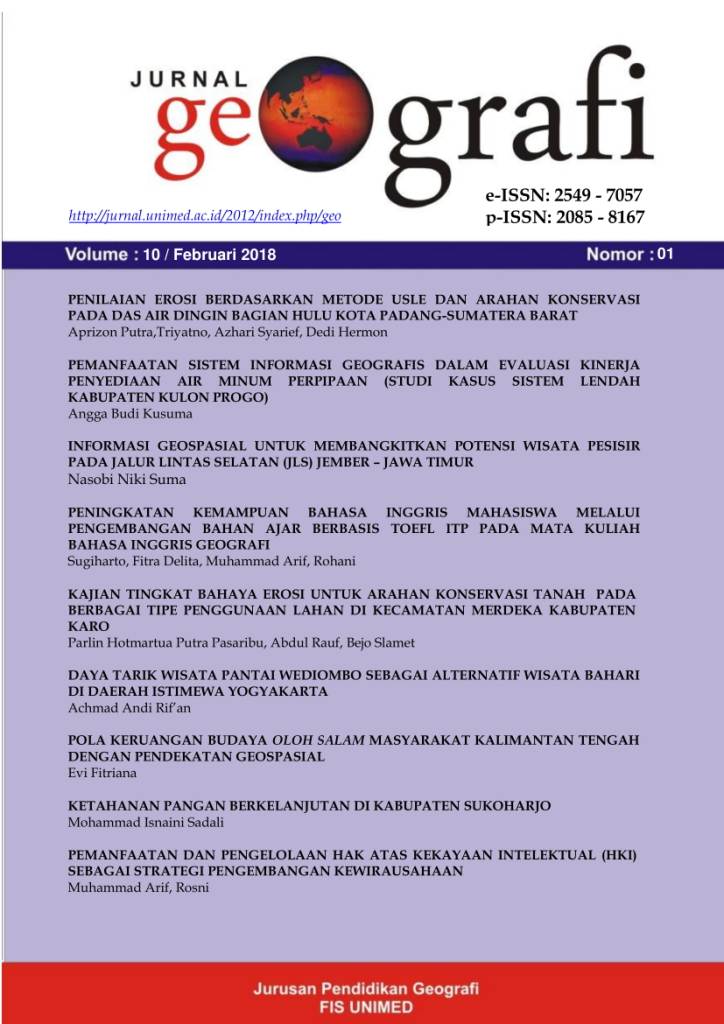Daya Tarik Wisata Pantai Wediombo Sebagai Alternatif Wisata Bahari Di Daerah Istimewa Yogyakarta
DOI:
https://doi.org/10.24114/jg.v10i1.7955Abstract
DIY (Daerah Istimewa Yogyalarta/ Special Region of Yogyakarta) coastal area has so many nice beaches that is very interesting to visit. One of them is Wediombo Beach. Wediombo Beach is not so well known by tourists yet, and still less famous than other beaches in DIY. This study intends to introduce Wediombo Beach as an alternative maritime tourism in the coastal area of DIY. The purpose of this research are: to identify the general profile of Wediombo Beach; to identify the tourist attractions offered Wediombo Beach; to identify the accessibility to the location of Wediombo Beach; and identify the characteristics of tourists visiting the Wediombo Beach. The method used in this study is a qualitative approach by using descriptive analysis using primary data obtained from the field survey, documentation, and in-depth interviews with official and the visitors / tourists. Wediombo Beach has many attractions that can attract tourists to visit, which can be classified as something to see, something to do, and something to buy. Accessibility to the beach Wediombo quite easily accessed which can be reached using public transport or private vehicles. Tourists visiting the beach Wediombo have different characteristics that can be seen from the age, gender, occupation, income, origin of tourists, and tourist motivation.Keywords: Coastal Tourism, Attraction, Accessibility, Tourists CharacteristicReferences
Bappeda Kabupaten Gunungkidul. (2010). Rencana Tata Ruang Wilayah Kabupaten Gunungkidul Tahun 2010-2030.
Hidayat, M. (2016). Strategi Perencanaan Dan Pengembangan Objek Wisata (Studi Kasus Pantai Pangandaran Kabupaten Ciamis Jawa Barat). Tourism & Hospitality Essentials (THE) Journal, 1(1), 33-44.
Karyono, H. (1997). Kepariwisataan. Jakarta: PT. Gramedia Widiasarana Indonesia.
Nieamah, K. F. (2014). Persepsi Wisatawan Mancanegara Terhadap Fasilitas Dan Pelayaan Di Candi Prambanan. Jurnal Nasional Pariwisata, 6(1), 39-45.
Nurisyah, S. (2001). Rencana pengembangan fisik kawasan wisata bahari di wilayah pesisir Indonesia. Buletin Taman Dan Lanskap Indonesia. Perencanaan, Perancangan dan Pengelolaan, 3(2).
Rif™an, A. A. (2014). Pemilihan Lokasi Pengembangan Pemukiman sebagai Upaya Adaptasi terhadap Banjir Pasang dan Perubahan Garis Pantai. Tesis. Yogyakarta: Universitas Gadjah Mada.
Rif™an, A. A. (2016). Tourism Components and Tourists Characteristic of Prambanan Temple as The World Culture Heritage Site in Yogyakarta, Indonesia. International Journal of Tourism and Hospitality Study, 1(1).
Sayangbatti, D. P., & Baiquni, M. (2012). Motivasi dan Persepsi Wisatawan Tentang Daya Tarik Destinasi Terhadap Minat Kunjungan Kembali di Kota Wisata Batu. Jurnal Nasional Pariwisata, 5(2), 126-136.
Soekadijo, R. G. (2000). Anatomi Pariwisata (Memahami Pariwisata sebagai Systemic Linkage). Jakarta : PT. Gramedia Pustaka Umum
Kusmawan, A. T. (2013). Pengaruh Perubahan Iklim terhadap Kagiatan Wisata Bahari di Gili Trawangan. Jurnal Nasional Pariwisata, 5(2), 137-145.
Wardiyanta. (2006). Metode Penelitian Pariwisata. Yogyakarta: ANDI.
http://forum.detik.com/pantai-favorit-para-pemancing-di-yogyakarta-t1330332.html diakses tanggal 5 Agustus 2016







